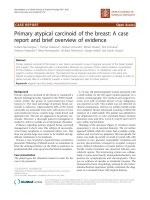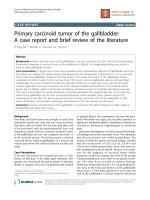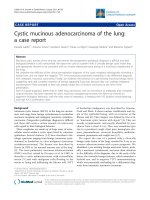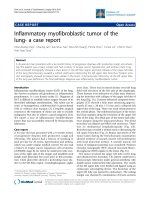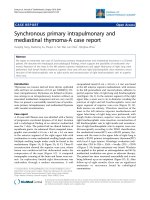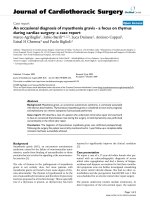Báo cáo y học: "An unusual presentation of multiple myeloma: a case report." pps
Bạn đang xem bản rút gọn của tài liệu. Xem và tải ngay bản đầy đủ của tài liệu tại đây (222.53 KB, 3 trang )
BioMed Central
Page 1 of 3
(page number not for citation purposes)
Journal of Medical Case Reports
Open Access
Case report
An unusual presentation of multiple myeloma: a case report
Catherine B Molloy*
1,2
, Rahul A Peck
2
, Stephen J Bonny
3
, Simon N Jowitt
3,4
,
John Denton
5
, Anthony J Freemont
5
and Abbas A Ismail
2
Address:
1
Rheumatology, St. Michaels Hospital, Toronto, Canada,
2
Rheumatology, Stockport NHS Trust, UK,
3
Haematology, Stockport NHS Trust,
UK,
4
Haematology, Salford Royal NHS Trust, UK and
5
Osteoarticular Pathology, Manchester University, UK
Email: Catherine B Molloy* - ; Rahul A Peck - ;
Stephen J Bonny - ; Simon N Jowitt - ;
John Denton - ; Anthony J Freemont - ;
Abbas A Ismail -
* Corresponding author
Abstract
Multiple myeloma can occasionally manifest with joint disease. We report the case of an individual
with a progressive bilateral carpal syndrome and a symmetrical severe seronegative polyarthritis
and joint swelling. Investigations revealed an erosive seronegative inflammatory arthritis in
association with bilateral carpal tunnel syndrome, anaemia, hepatic impairment and nephrotic-range
proteinuria. Synovial fluid cytology demonstrated plasmablasts and multinucleated cells with
products of chondrolysis. The diagnosis of multiple myeloma (with secondary amyloidosis) was
made on serum protein electrophoresis and bone marrow biopsy.
The relationship between myeloma and joint disease is discussed, highlighted by the presence in
this case of all three pathogenic features associated with arthritis in myeloma patients- an erosive
arthritis, carpal tunnel syndrome and an invasive tumoural arthritis.
Background
Multiple myeloma is a malignant proliferation of plasma
cells producing a monoclonal paraprotein. Multiple mye-
loma can present in a range of ways, for example, hyper-
calcaemia, hyperviscosity, renal failure and bone pains/
fractures. We report an unusual presentation of multiple
myeloma in the form of symmetrical severe polyarthritis
and joint swelling.
Case presentation
A 55 year old lady referred to the rheumatology clinic with
a 3 month history of progressive disabling polyarthralgia
and joint swelling, a 5 kg weight loss and fatigue. The pre-
dominant joints affected were her knees, shoulders, wrists
and small hand joints; her hand function was so impaired
at the time of presentation that she was no longer able to
feed herself. She denied joint stiffness, thigh pain, a his-
tory of skin rash, gastrointestinal or genitourinary symp-
toms.
On examination she was pale and cachectic. She had gen-
eralised soft tissue swelling of her hands, with markedly
reduced wrist movements, but without synovitis. Tinel's
and Phalen's tests were strongly positive bilaterally con-
sistent with carpal tunnel syndrome. Moderate cool effu-
sions were present in both knees. No synovitis was present
elsewhere and the rest of her systemic examination was
normal.
Published: 10 September 2007
Journal of Medical Case Reports 2007, 1:84 doi:10.1186/1752-1947-1-84
Received: 16 June 2007
Accepted: 10 September 2007
This article is available from: />© 2007 Molloy et al; licensee BioMed Central Ltd.
This is an Open Access article distributed under the terms of the Creative Commons Attribution License ( />),
which permits unrestricted use, distribution, and reproduction in any medium, provided the original work is properly cited.
Journal of Medical Case Reports 2007, 1:84 />Page 2 of 3
(page number not for citation purposes)
She had a normochromic anaemia with a borderline leu-
copaenia (Hb 65 g/l, MCV 80 fl, WCC 3.9 × 10
9
/l, platelets
200 × 10
9
/l) and a grossly raised ESR (>140 mm/hr). She
was hypercalcaemic (corrected calcium 3.15 mmol/l,
phosphate 1.82 mmol/l, alkaline phosphatase 102 U/l)
with deranged liver function (LDH 1085 U/l, AST 46 U/l,
normal bilirubin, albumin and globulin levels). Signifi-
cant renal disease was evident (urea 22 mmol/l, creatinine
407 µmol/l), +1 of blood and protein on urinalysis, a cre-
atinine clearance of 16 ml/min and nephrotic range pro-
teinuria (5.29 g/d). Hand radiographs showed wrist joint
space narrowing with juxta-articular erosions.
Left knee synovial fluid cytology revealed atypical cells
resembling plasmablasts and multinucleate cells, as well
as changes consistent with chondrolysis, figure 1. It was
felt this was due to malignant infiltration of cartilage, with
bone and cartilage degradation products present in the
fluid. Wrist aspiration was dry.
Subsequently, rheumatoid factor, ANA, ENA and ANCA
were all negative and a non-contrast CT scan of her thorax,
abdomen and pelvis did not identify any abnormalities of
the viscera or the skeleton.
A panhypogammaglobulinaemia was identified [IgG was
3.7 g/l (8–16), IgA and IgM were both 0.1 g/l (1.4–4, 0.5–
2)]. Electrophoresis identified a small paraprotein band
(2 g/l), and a large amount of free kappa light chains in
both the serum and the urine (8.8 mg/l). Haematological
advice was sought and bone marrow biopsies were under-
taken, demonstrating a heavy (>90%) infiltration by
plasma cells including atypical forms, with a marked
reduction in granulopoiesis and erythropoiesis. Amyloid
protein was also identified in the walls of blood vessels
within the trephine biopsy.
Thus a diagnosis of aggressive multiple myeloma was
made (stage IIIB) and the patient was treated with aggres-
sive VCADVCAD chemotherapy (vincristine, cyclophos-
phamide, adriamycin and dexamethasone).
Unfortunately, she died from pneumonia seven weeks
after presentation.
Discussion
We have described the initial presentation of an aggressive
multiple myeloma with an erosive seronegative polyar-
thritis due to direct myelomatous joint infiltration. On
review of the literature, a few case reports have described
articular presentations of the plasma cell dyscrasias-multi-
ple myeloma (MM) [1,2], monoclonal gammopathy of
uncertain significance (MGUS) [1,2] and Waldenström's
macroglobulinaemia [3].
Joint involvement in myeloma is typically an oligoarthri-
tis [1] or a polyarticular rheumatoid-like pattern, as seen
in this case. Though individuals with myeloma are at
greater risk of both septic arthritis and gouty arthritis [3],
other pathophysiological mechanisms have been postu-
lated to account for joint disease. Firstly, local synovial
precipitation of cryoprecipitable paraproteins [1,4] or
immunoglobulin crystals [4] may activate the inflamma-
tory response resulting in an erosive arthritis [2]. Sec-
ondly, a carpal tunnel syndrome may develop from
intrasynovial deposition of amyloid protein or immu-
noglobulins [5]. Finally, juxta-articular plasmacytic
lesions may infiltrate the synovium and synovial fluid
resulting in a 'tumoural arthritis'. This direct tumour inva-
sion of the joint has been identified in other primary hae-
matological malignancies [3,6-8], however it is an
extremely rare manifestation of the plasma cell dyscrasias,
having only previously been described in 2 individuals
with myeloma [3,8]. This case demonstrated all of these
three pathogenic features- an erosive arthritis, carpal tun-
nel syndrome and an invasive tumoural arthritis.
This case is also unique in that the synovial fluid analysis
yielded the ultimate diagnosis. In a case series of 9 indi-
viduals with a monoclonal gammopathy (MGUS or MM)
and arthritis, the majority [5] were diagnosed with the
plasma dyscrasia first, synchronous diagnoses were made
in 3, and arthritis was the presenting feature in only 1 case
[1]. There is no information on the prognosis of cases pre-
senting in this manner, but based on the presence of anae-
mia, hypercalcaemia, renal impairment, advanced lytic
bone lesions and high tissue M-component levels in this
case, a high myeloma tissue mass was present, related to a
poor prognosis [9].
Knee synovial fluid: plasmablast-like cell containing particles of phagocytosed degenerate articular cartilage surrounded by suspended degenerate cartilage (Jenner Giemsa, ×1000)Figure 1
Knee synovial fluid: plasmablast-like cell containing particles
of phagocytosed degenerate articular cartilage surrounded by
suspended degenerate cartilage (Jenner Giemsa, ×1000).
Informed consent was given for publication from the patient's
next-of-kin.
Publish with BioMed Central and every
scientist can read your work free of charge
"BioMed Central will be the most significant development for
disseminating the results of biomedical research in our lifetime."
Sir Paul Nurse, Cancer Research UK
Your research papers will be:
available free of charge to the entire biomedical community
peer reviewed and published immediately upon acceptance
cited in PubMed and archived on PubMed Central
yours — you keep the copyright
Submit your manuscript here:
/>BioMedcentral
Journal of Medical Case Reports 2007, 1:84 />Page 3 of 3
(page number not for citation purposes)
Conclusion
We report the case of a patient presenting with tumoural
arthritis and carpal tunnel syndrome from an aggressive
myeloma. This case stresses the importance of analysing
the synovial fluid of any patient with an atypical joint dis-
ease or a suspected plasma cell dyscrasia for cytology and
immunohistochemistry, micro-organisms, crystals, and
also for immunoglobulins and amyloid.
Competing interests
The author(s) declare that they have no competing inter-
ests.
Authors' contributions
The authors were involved in the writing of the manu-
script or patient clinical care. All authors read and
approved the final manuscript.
Acknowledgements
The authors declare no funding was required for the writing and submission
of the manuscript. Informed written consent was received from the patient
for publication of the manuscript.
References
1. Jorgensen C, Guerin B, Ferrazzi V, Bologna C, Sany J: Arthritis asso-
ciated with monoclonal gammopathy: clinical characteris-
tics. Br J Rheumatol 1996, 35:241-243.
2. Vitalli C, Baglioni P, Vivaldi I, Cacialli R, Tavoni A, Bombardieri S: Ero-
sive arthritis in monoclonal gammopathy of unknown signif-
icance: report of four cases. Arthritis Rheum 1991, 34:1600-1605.
3. Roux S, Fermand JP, Brechignac S, Mariette X, Kahn MF, Brouet JC:
Tumoral joint involvement in multiple myeloma and Wal-
denströms macroglobulinaemia- report of 4 cases. J Rheuma-
tol 1996, 23: 2175-2178.
4. Langlands D, Dawkins R, Matz I: Arthritis associated with a crys-
tallizing cryoprecipitable IgG paraprotein. Am J Med 1980,
68:461-465.
5. Wiernik P: Amyloid joint disease. Medicine (Baltimore) 1972,
51:465-478.
6. Evans T, Nercessian B, Sanders K: Leukaemic arthritis. Arthritis
Rheum 1994, 24:48-56.
7. Rice D, Semble E, Ahl E, Bohrer S, Rothberger H: Primary lym-
phoma of bone presenting as monoarthritis. J Rheumatol 1984,
11:851-854.
8. Villiaumey J, Larget-Piet B, Pointud P: Les complications articu-
laires de la maladie de Kahler. Résultats d'une enquête por-
tant sur 1953 dossiers de myélomes plasmocytaires. Rev
Rhum Mal Osteoartic 1975, 42:25-34.
9. Durie BGM, Salmon SE: A clinical staging system for multiple
myeloma. Correlation of measured myeloma cell mass with
presenting clinical features, response to treatment and sur-
vival. Cancer 1975, 36:842-854.

